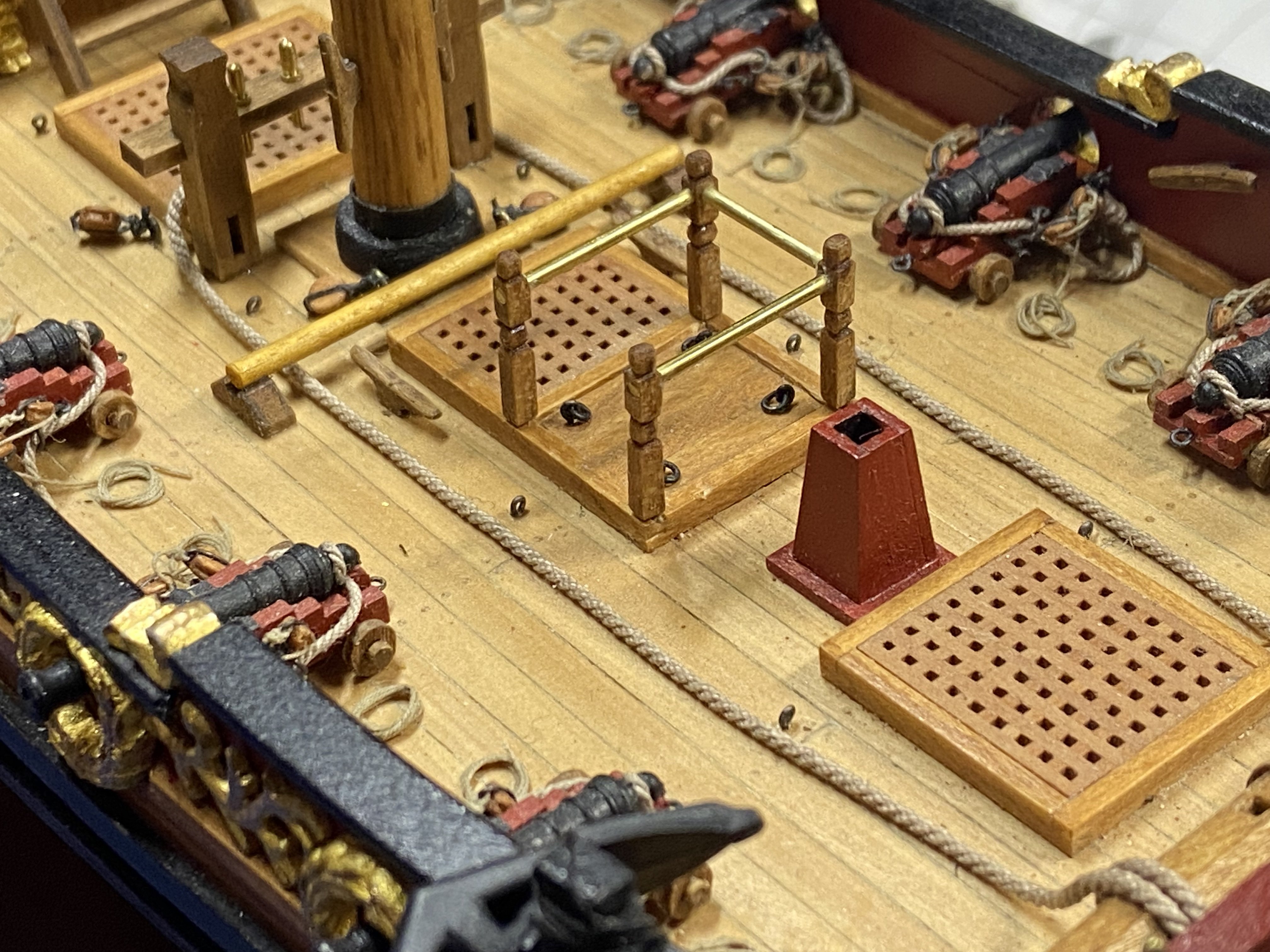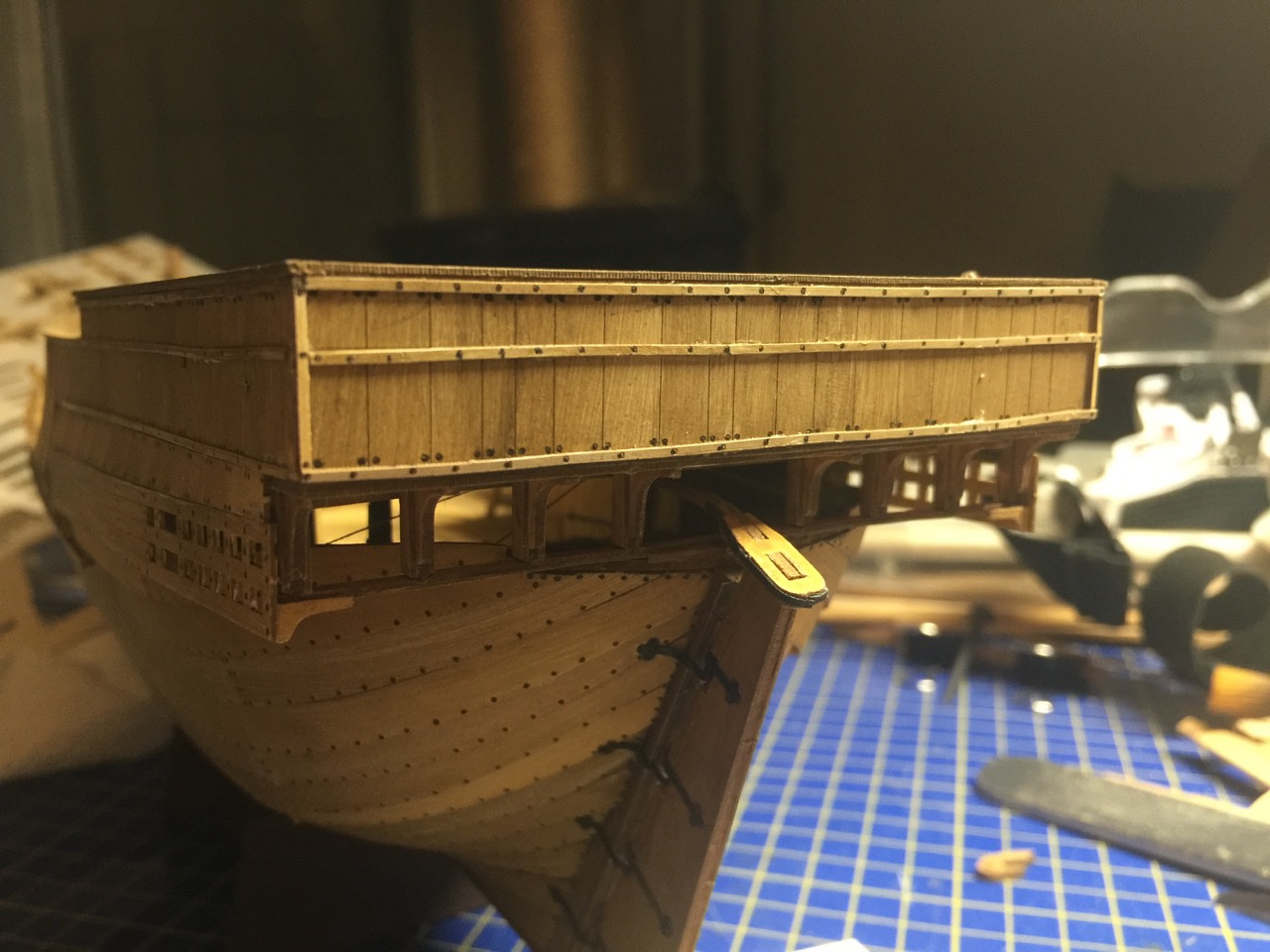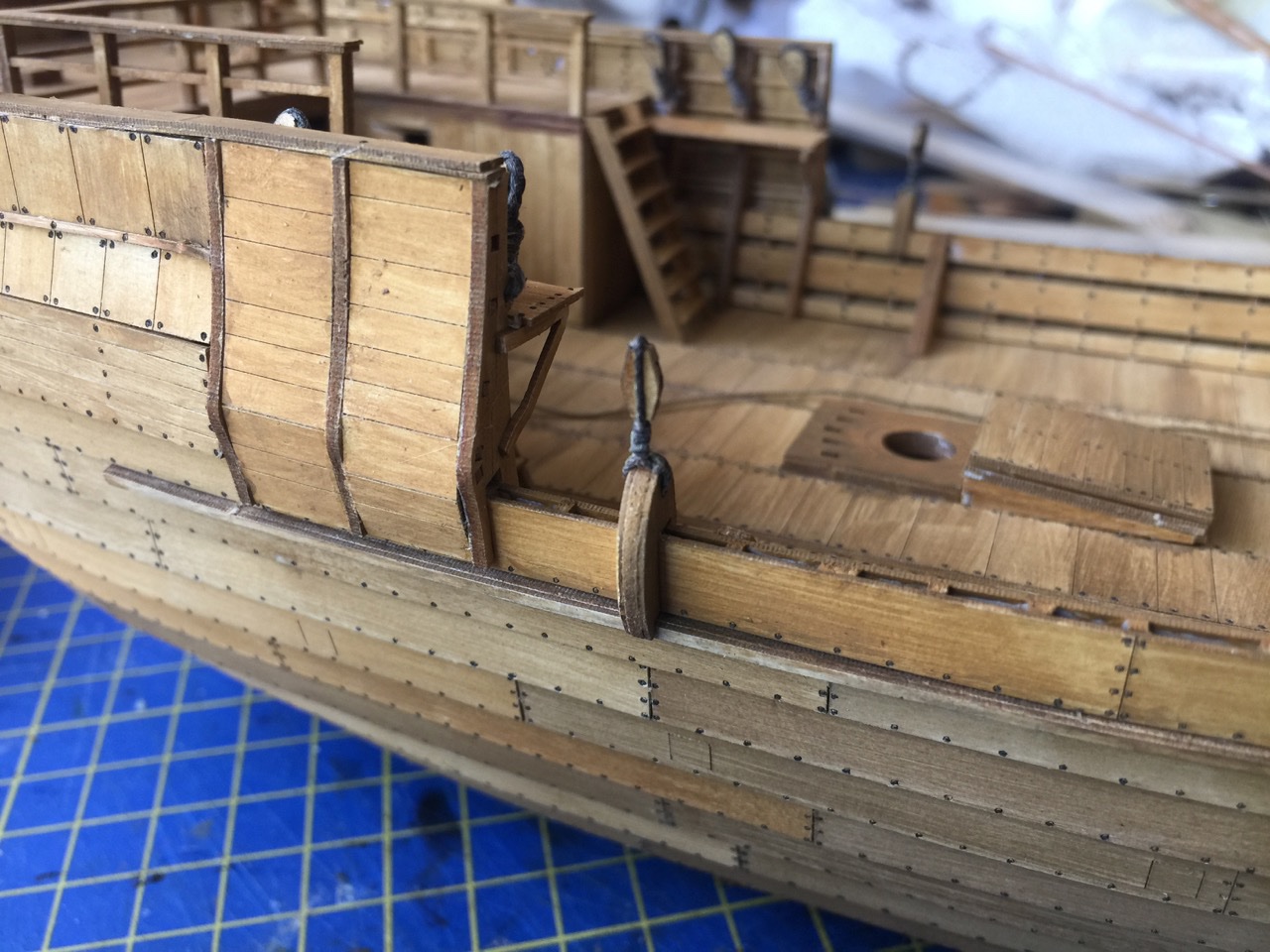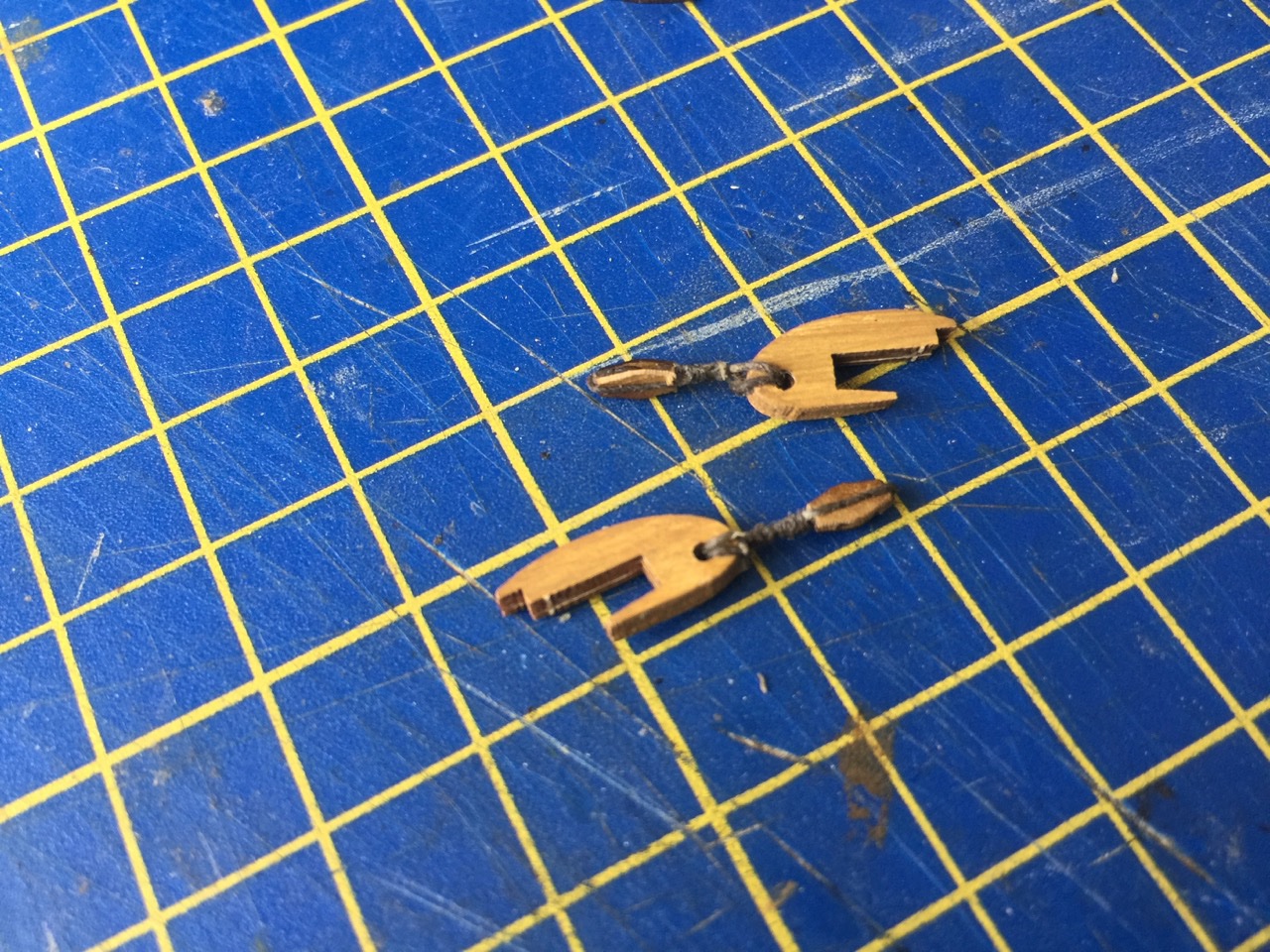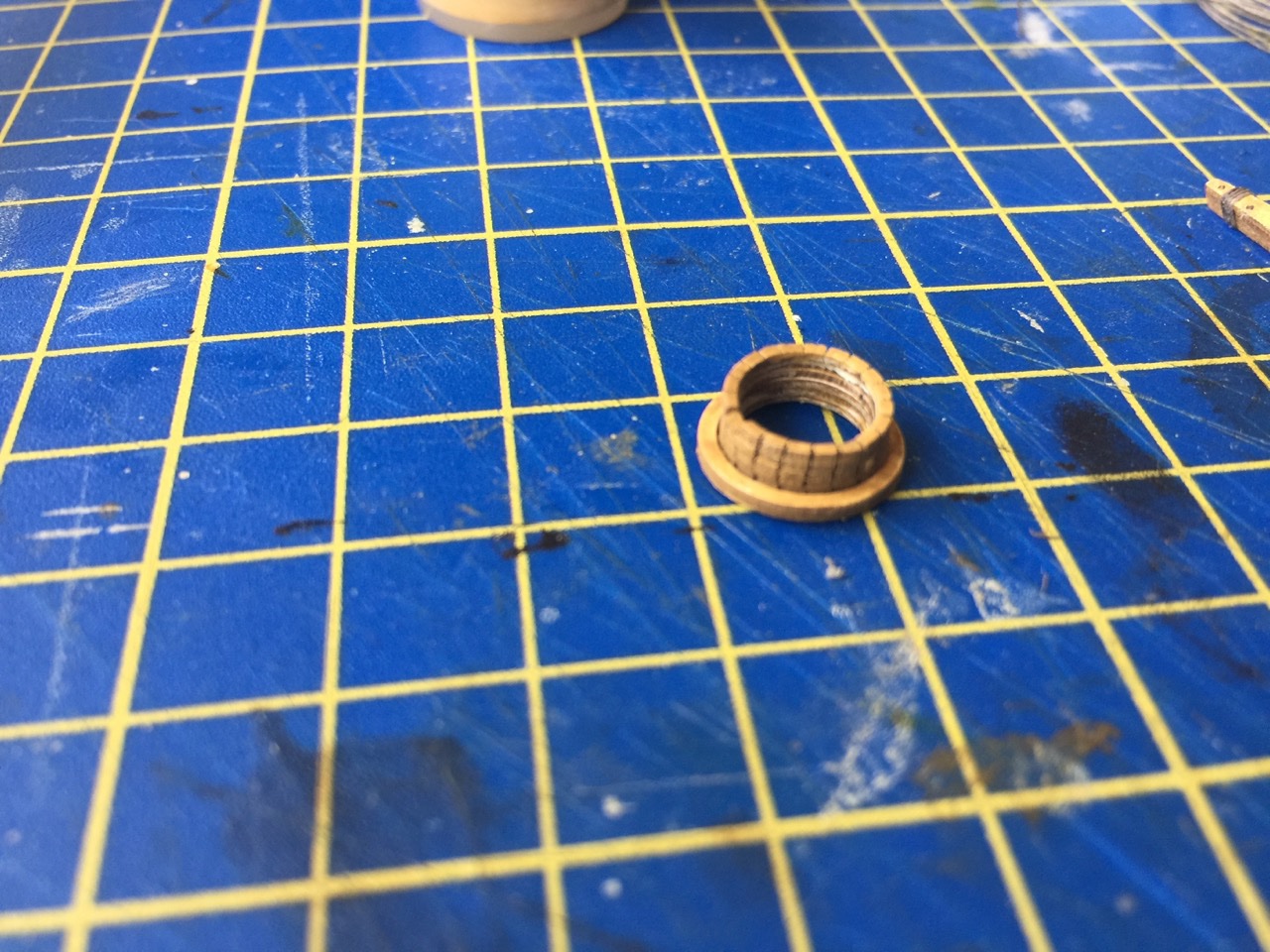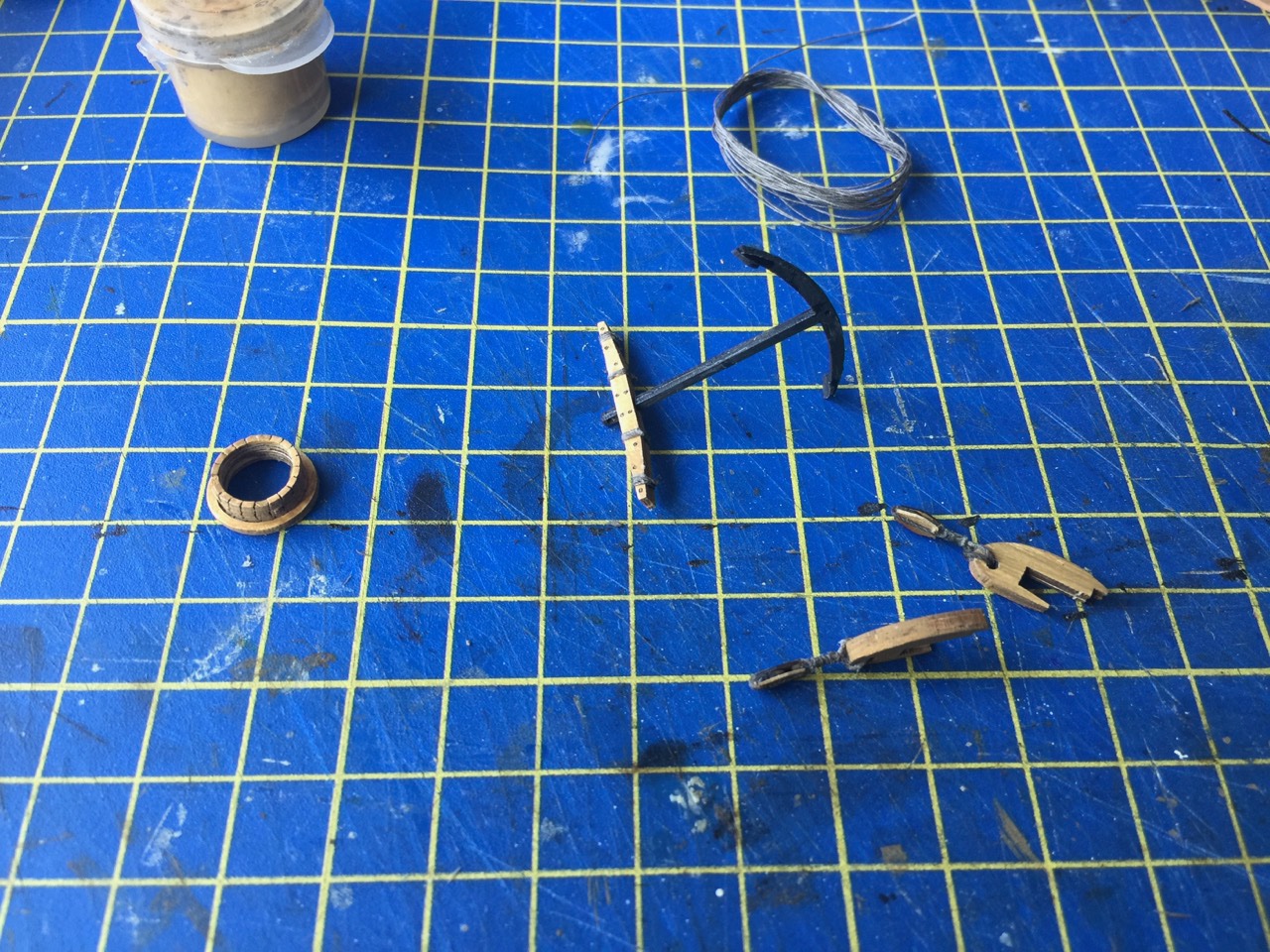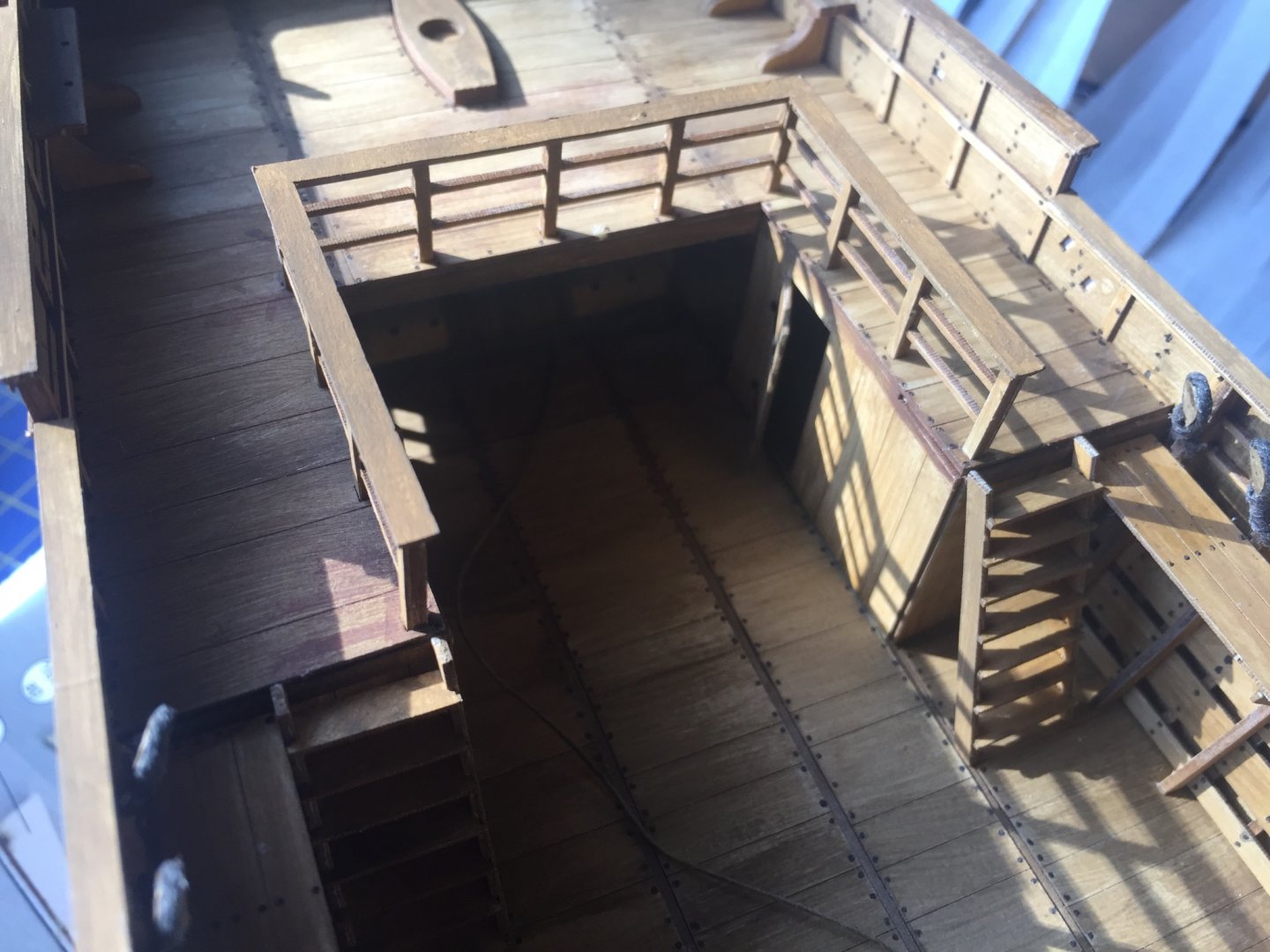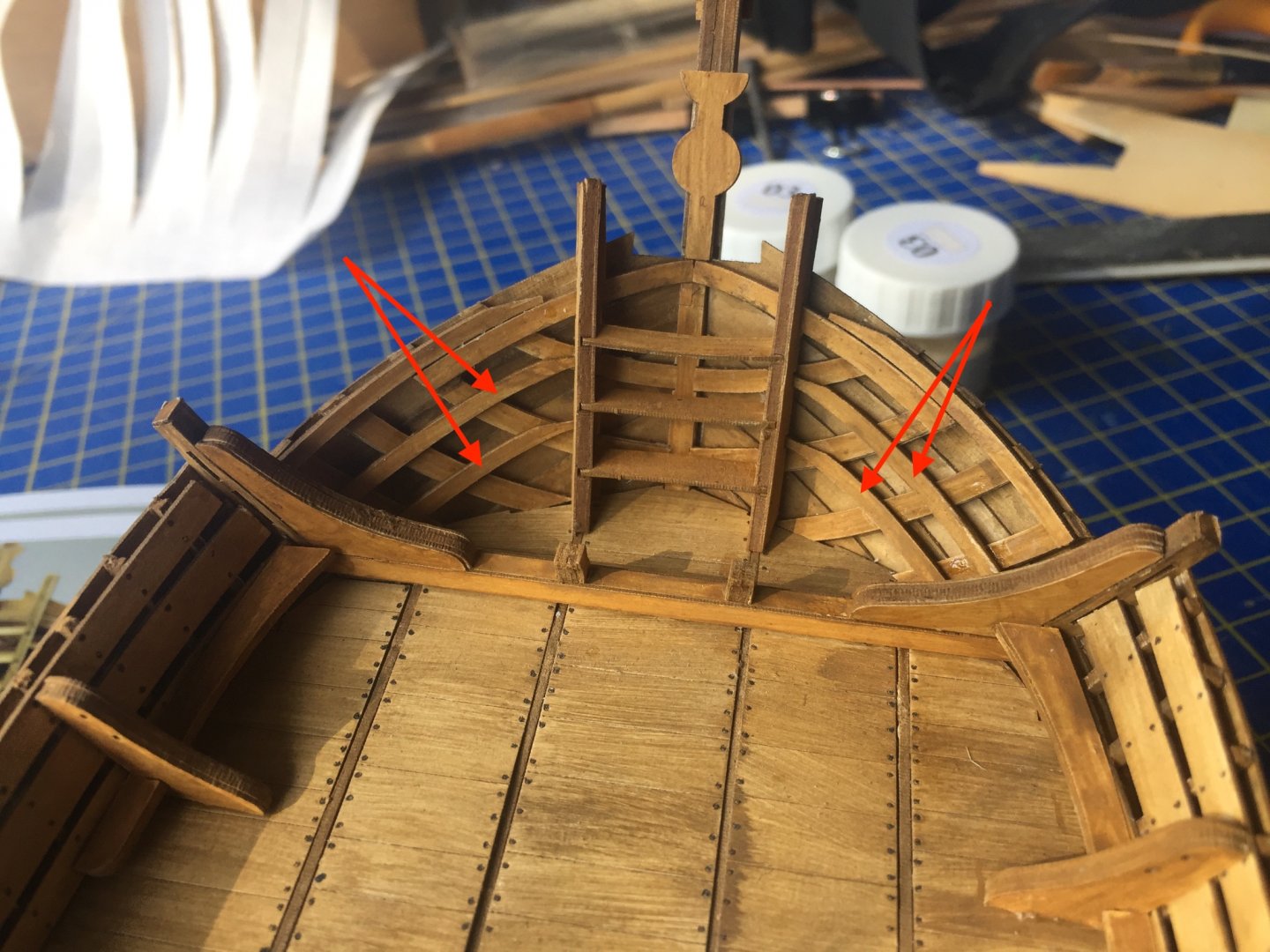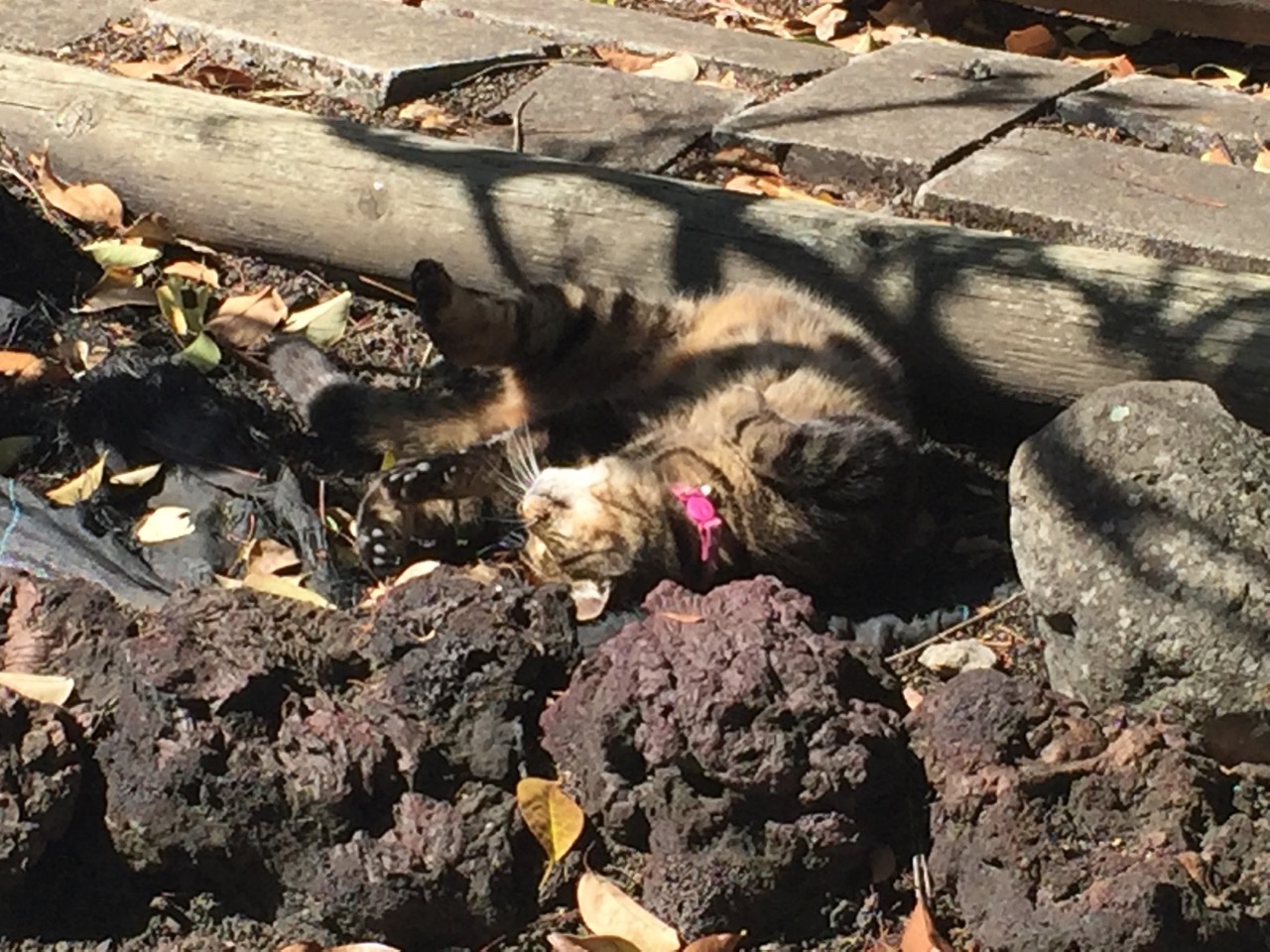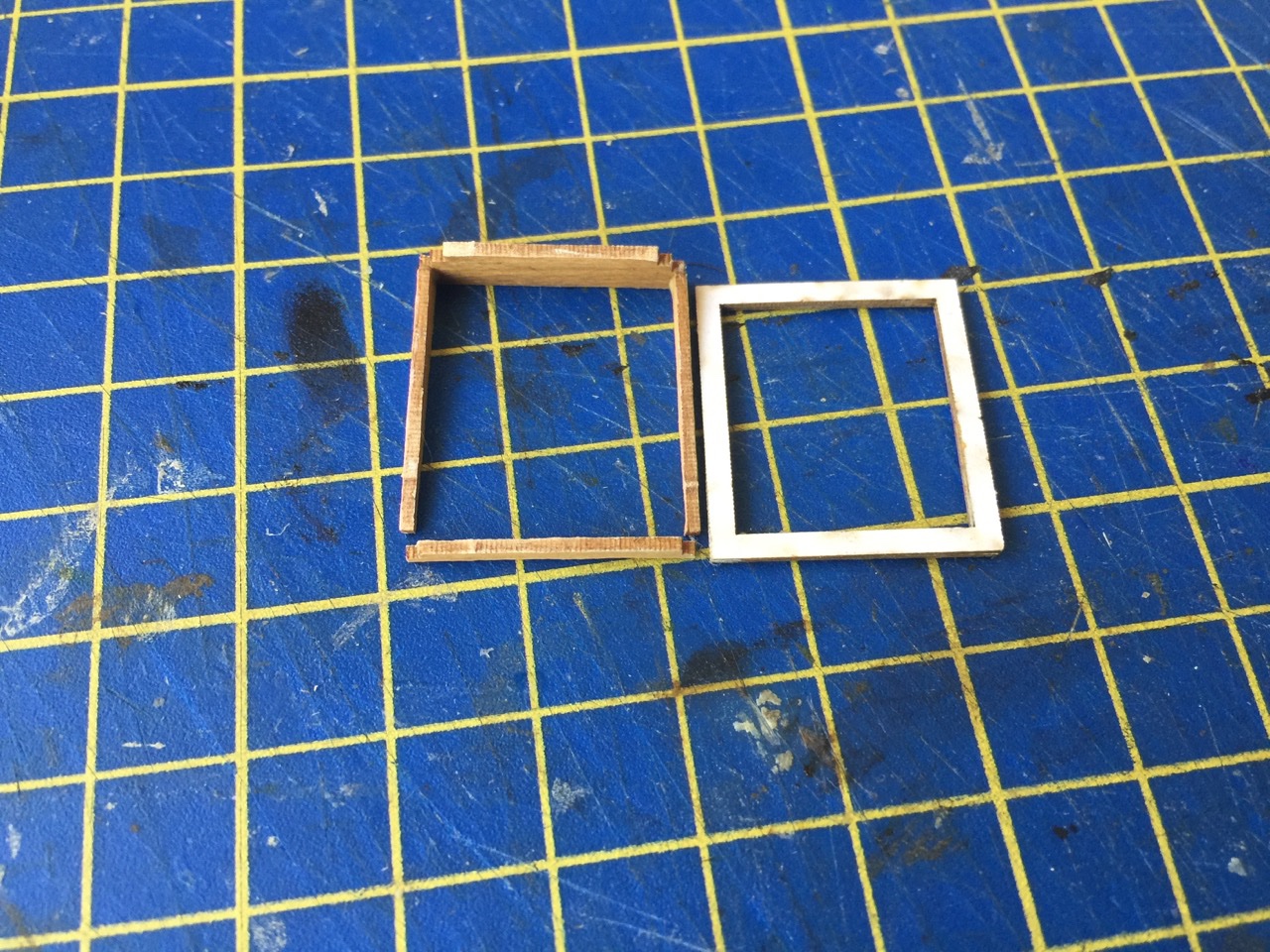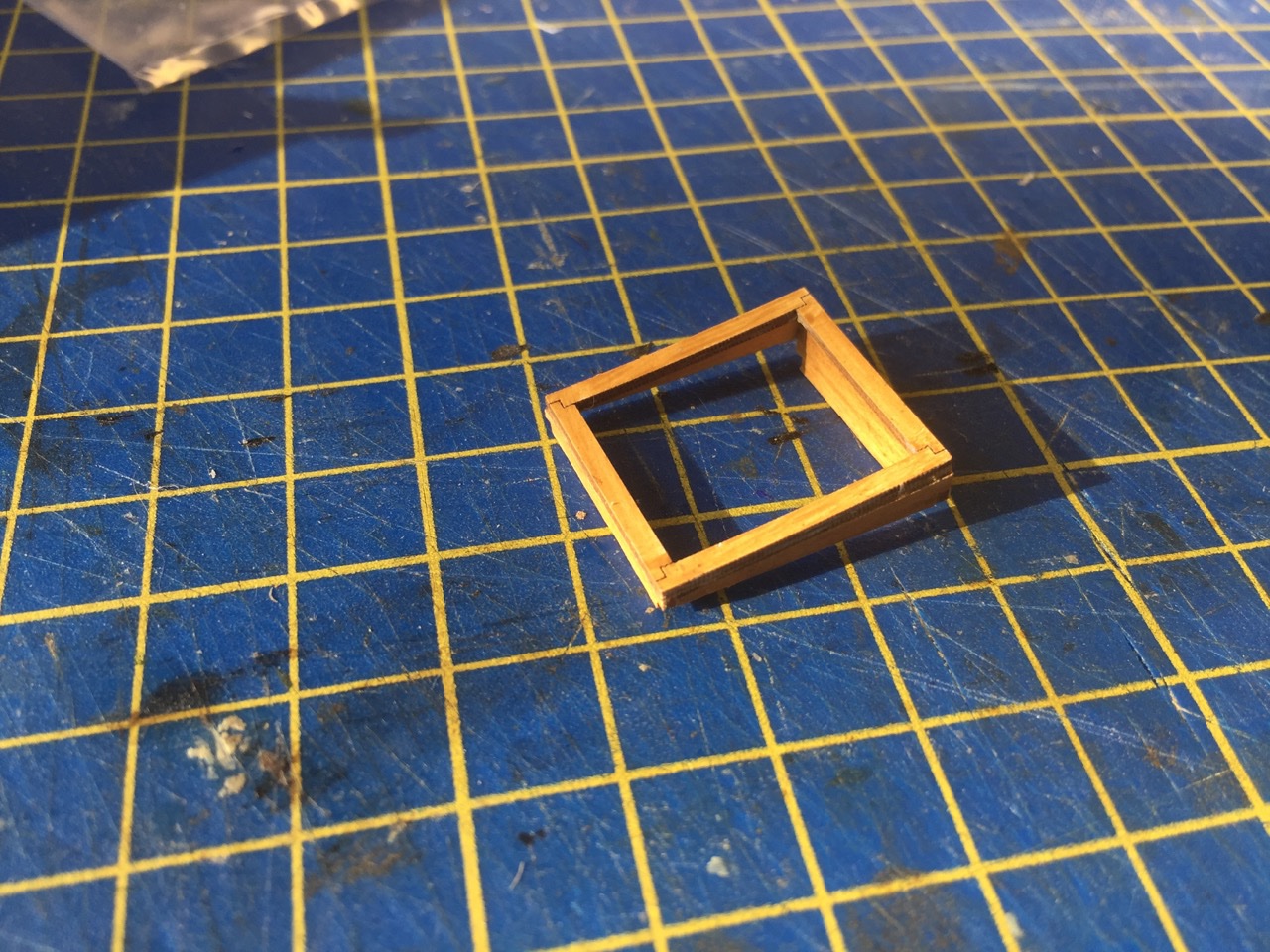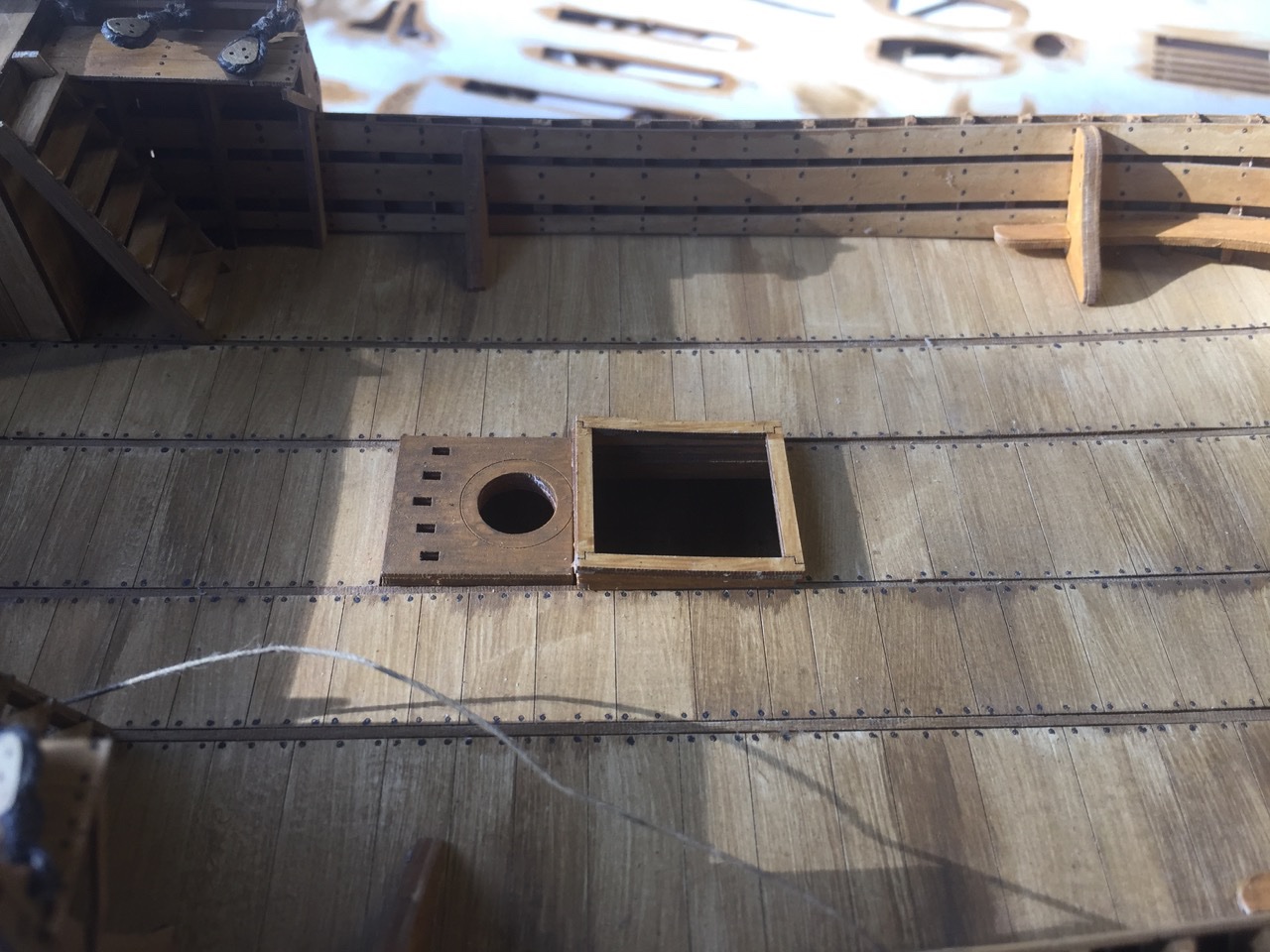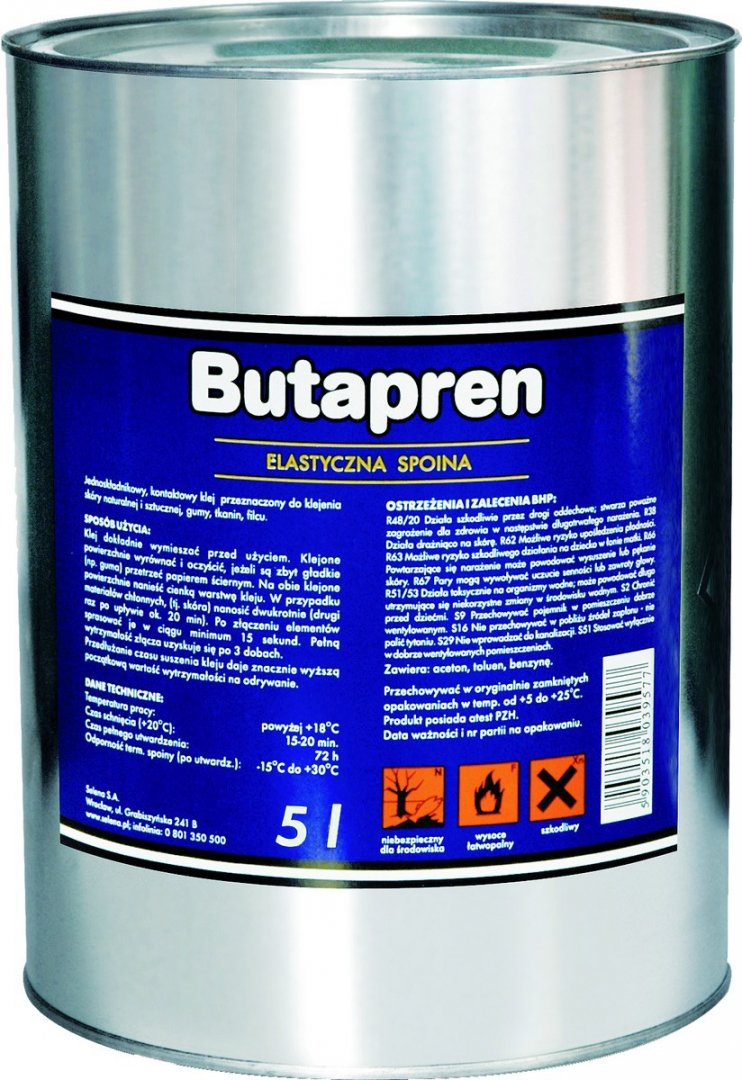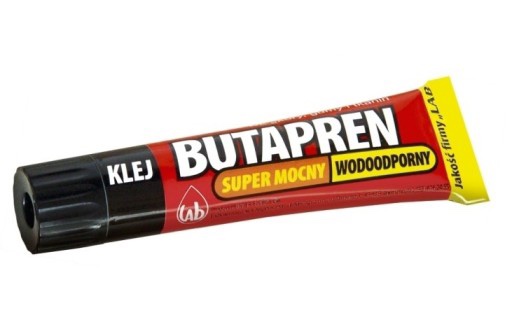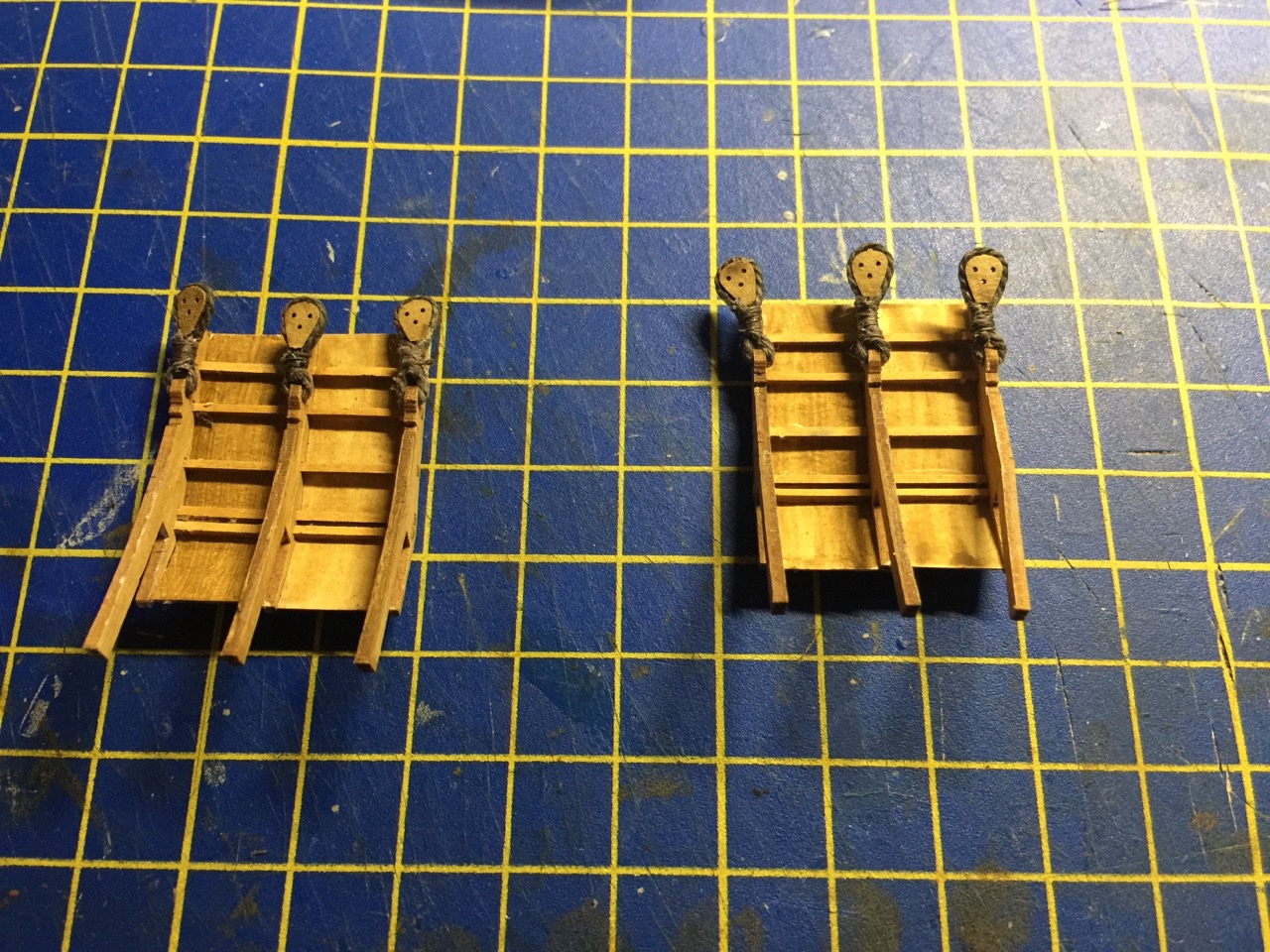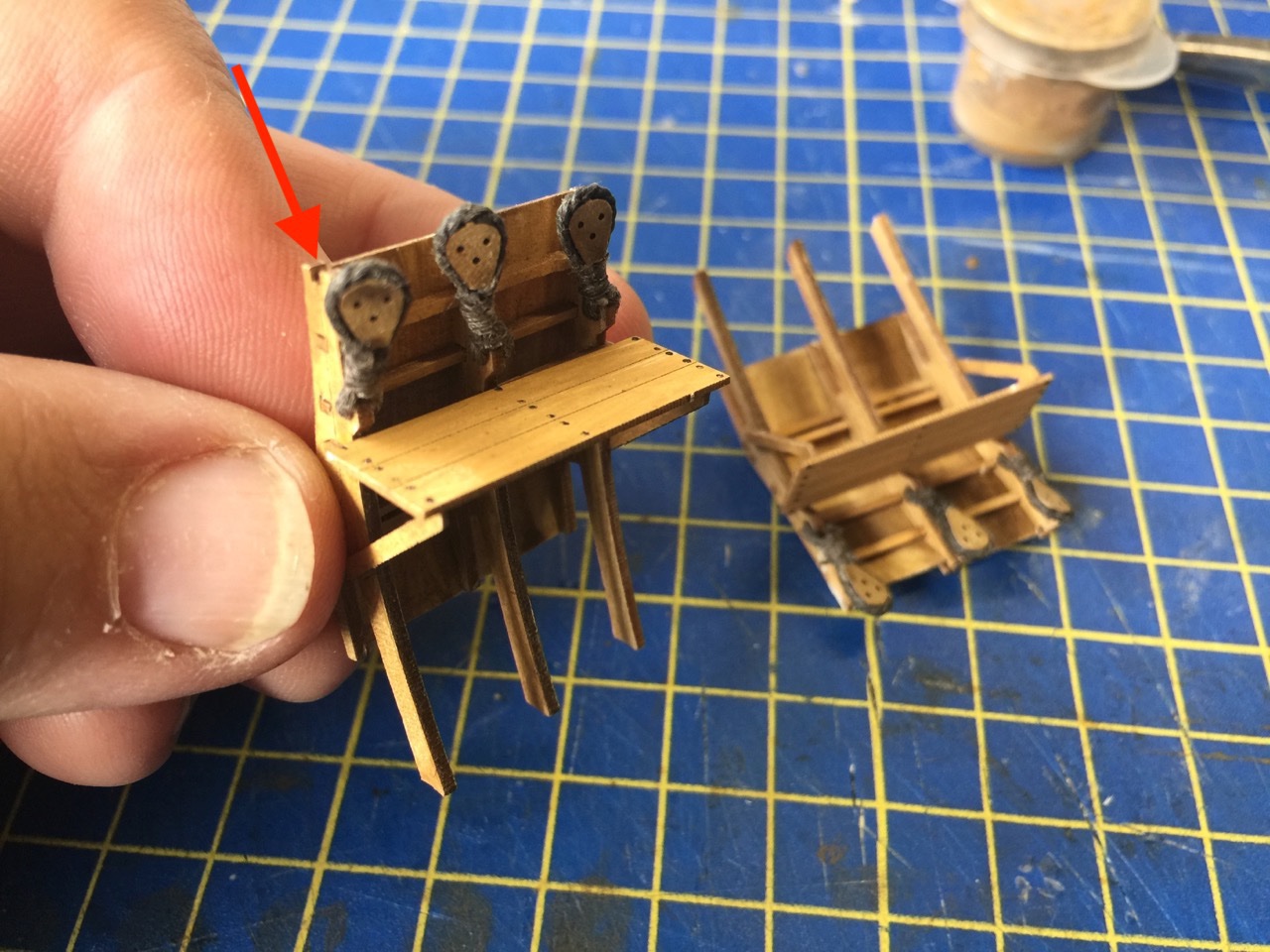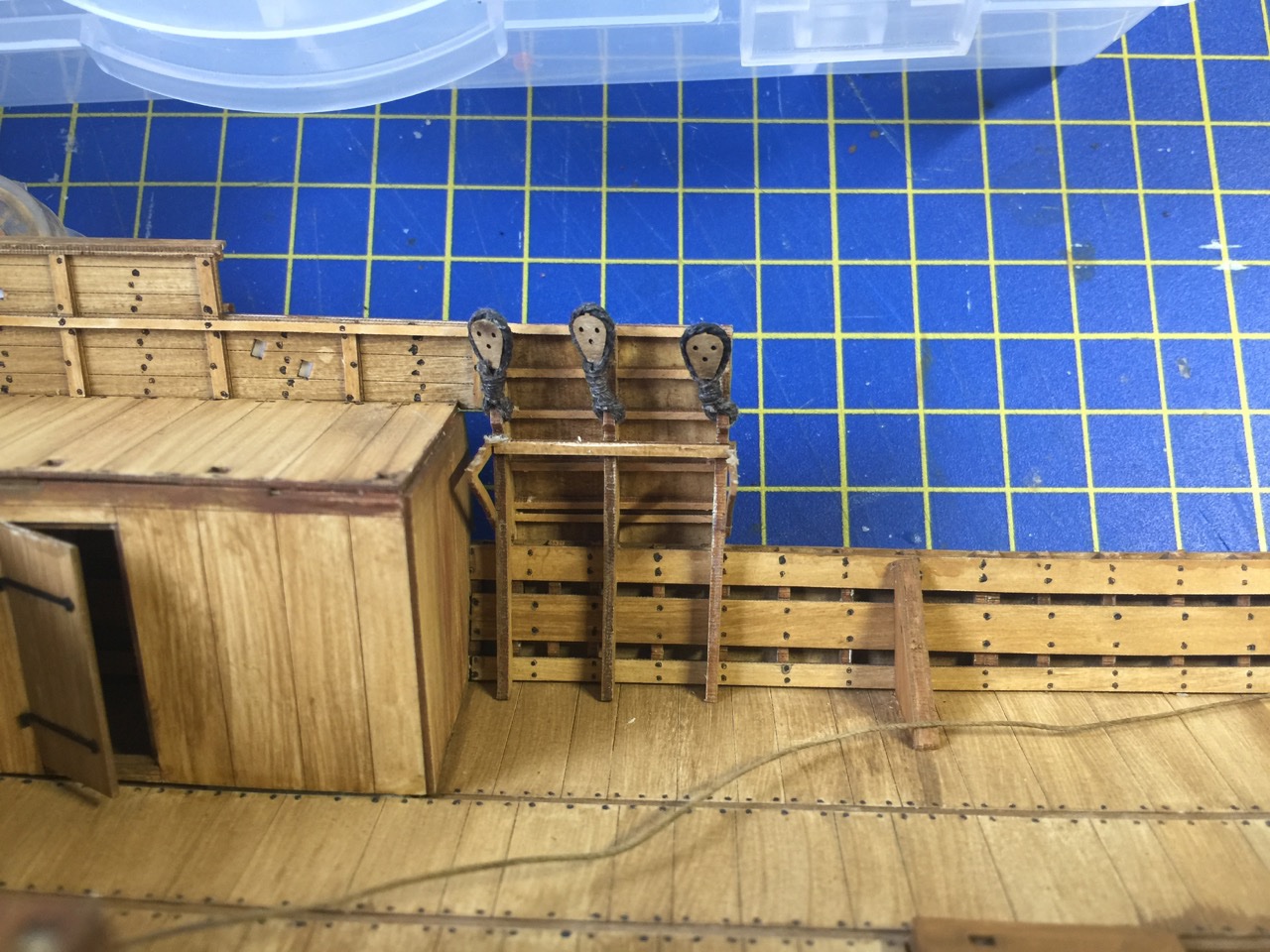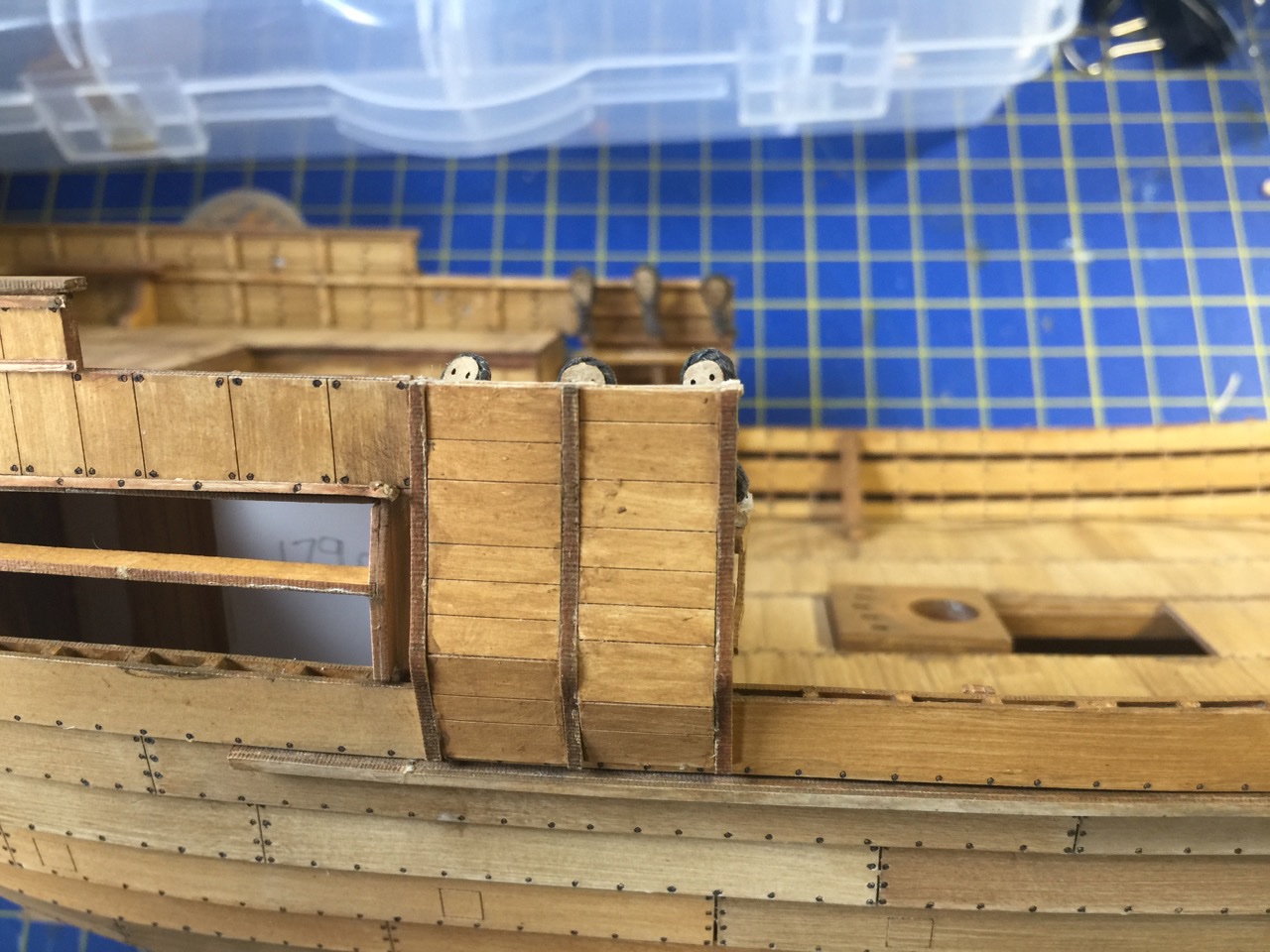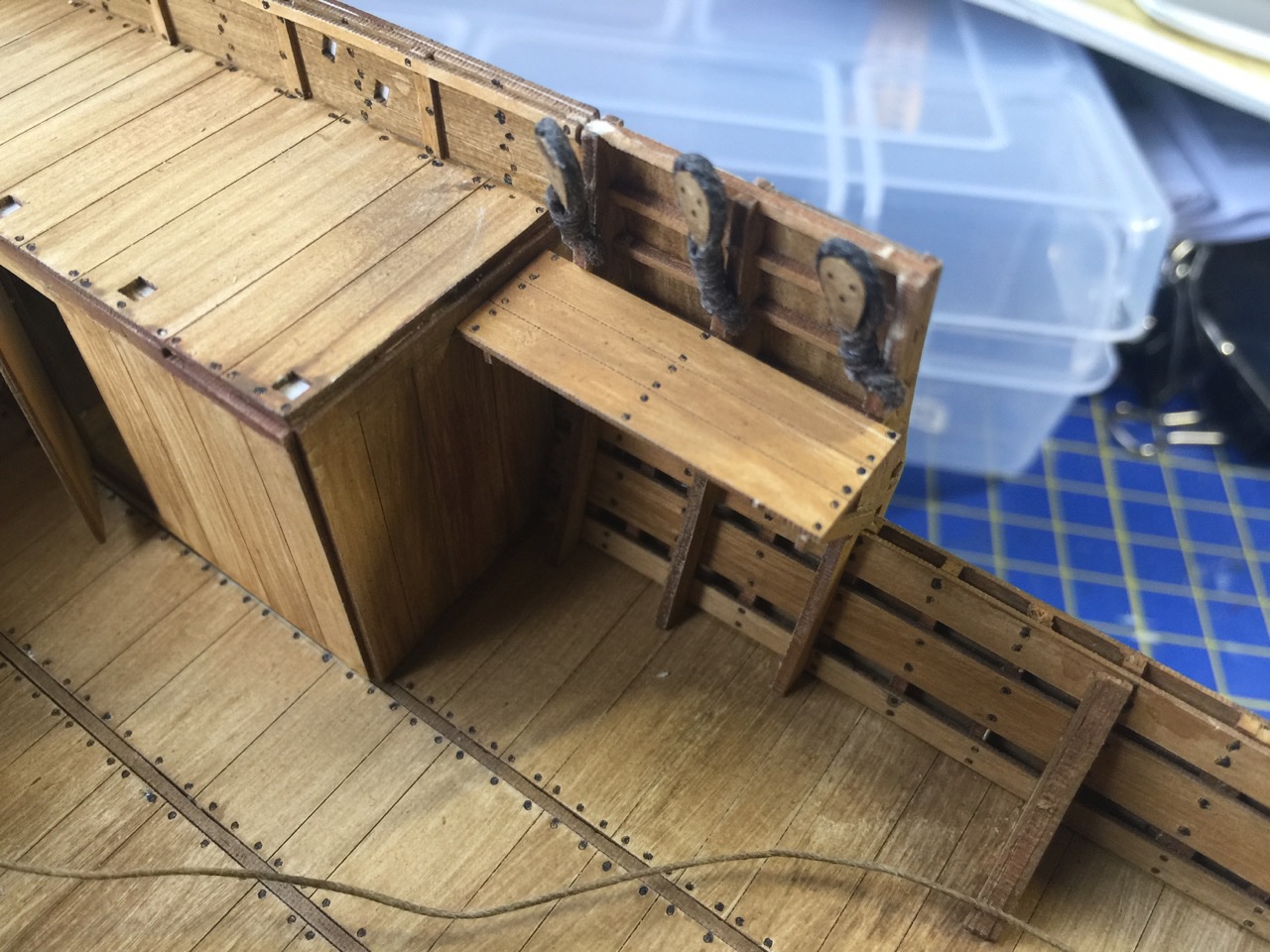-
Posts
1,858 -
Joined
-
Last visited
Content Type
Profiles
Forums
Gallery
Events
Everything posted by catopower
-
Trying to make regular progress on the Bremen Cog. More doo-dads done and I started dying the line for the sail. The Shipyard kits include linen rigging line. It's very nice, but it's white. So, I've started staining more of it, most just enough to deal with current steps. I think I'm caught up on the "extra" parts I'm finding. I did discover that the instructions completely missed one set of parts that I found still on the parts sheets. These are what I might just call trim pieces or battens that fit on the aft side of the stern castle. The parts can be seen in some of the instruction photos, but they're never labeled to show you where they go. And as for the doo-dads, here are mast coat, anchor, and some pieces that mount to the hull for the attachment of the backstays. It's really pretty interesting how detail oriented these kits are. More so than most wooden kits I've seen (except for maybe the wooden versions of these cogs). If you look closely at the mast coat, it's actually built up from several laser-cut hoops. Most are cut and lined up so that they look the coat is made up many wedges, though mine look like they're leaning a little. But, the top hoop is laser engraved on the top face, so that it looks like the ends of the wedges. The engraving make this piece pretty delicate. Two larger hoops at the bottom complete the assembly. In all, the mast coat is made up of 8 pieces, and an expert modeler would have gotten the laser-cut details lined up perfectly so that the wedges didn't lean like mine do.
- 175 replies
-
- hanse kogge
- shipyard
-
(and 1 more)
Tagged with:
-

How to simplyfi the build of a large ship?
catopower replied to ubjs's topic in Wood ship model kits
Hi ubjs, maybe you're like me. I enjoy building hulls and I too like planking a lot, so I have a few hulls sitting around of various ships. Some are solid hull, some are plank-on-bulkhead, some are from kit, and some are from scratch. Eventually, when I finish a project, I look back at the various hulls to see if one of them speaks to me and asks to be turned into a finished model. Or maybe just to be more further toward completion. But, sometimes, it's more a matter of the dream of completing the model. I imagine how much I'd like to complete a kit, then I acquire the kit, get part way through it, but then I get a little stuck. Then a new, pretty model kit comes along, and it's too temping to switch to that one instead. I don't know if this is the case for you, but it's easy to get caught up into it, especially when you have enough financial means to acquire the kits. Personally, I'd suggesting taking one of the simpler kits you've started to completion. Then, come back to this Vasa kit. Then, you'll get more experience with the detailing of the wooden model kit, and some of the issues you will face on the smaller model, and more quickly overcome them. But, it's completely up to you. You have to build what you enjoy building! Heck, what's another planked hull in the grand scheme of life? 😁 Edit: As I write this, I am thinking about how I am working to finish my Hanse Kogge von Bremen card model, and my Japanese coastal transports, both in the rigging stage, while I recently cut the parts to build the hull of the cutter Cheerful, cut the backbone or false keel for the hull of the French lugger Le Coureur, and am prepping the plans for a build of the French cutter Le Cerf. I can't help it, I love building hulls. But, I do have to restrain myself often! -

How to simplyfi the build of a large ship?
catopower replied to ubjs's topic in Wood ship model kits
Hi bujs, Learn what you can and have fun. Remember that ship modeling is a personal experience and the ship model is yours to do with as you please. When you ask questions about how to do something, invariably, you'll get a range of answers that are mostly meant to help you build a ship model kit in a way that will provide you with the best looking results. When you choose a different path, many of us are always going to want to tell you things to try to get you back on that path to the best looking model. I started to post my own replies here in this thread a couple times. But, it's difficult as a long-time ship modeler to know how to encourage beginners without sounding controlling. So, I deleted them. But, there have been some good ideas here about simplifying the build. And, though you refer to the Billing Boats Wasa as a simple kit, there's a reason they classify it as an expert level kit. So, just bear that in mind. Hopefully, by simplification, you don't mean to rush the build. That may result in crooked frames, twisted hull, bulging or uneven planking. But, if understand you correctly, this is going to be something of a "sacrificial" build? That is one that you make all the mistakes on and plan to throw away if it's bad enough. Or is it that you want to really build a nice model here, but maybe less detailed? That's the only way I can see building this model in a "simpler" way. In any case, good luck with both builds! -
Welcome Matey0143! I agree with Chris on the Mastini book. Another book, while a lot of the company specific address references are dated, Ship Modeling from Stem to Stern by Milton Roth was an old classic, and much of the technique information applies, as do discussions on scale, rope sizing, and so on. It was actually the first ship modeling book in my library when I was starting out. Of course, the fact that that was over 16 years ago indicates just how dated those the company references are (for paint suppliers, tool suppliers, etc). Probably, the one book that I truly consider my ship modeling bible is the now-out-of-print Historic Ship Models by Wolfram zu Mondfeld. Not a how-to book, but a great reference for modelers, chock full of information. Good luck with your build and enjoy!
-
Card model making, with its large numbers of parts and limited instructions, resulted in another discovery the other day. I found some parts on a sheet that look like something I should have used by this point. So, I went back and checked the part number, then hunted through the instructions again to find that the parts were referenced many pages earlier. Gotta spot the little numbers in one of the photos. I realized it's a bit like finding Waldo... But, adding the parts at this stage was no problem. There are still plenty of parts and I'm approaching the end of the main build. So, I'm hoping I haven't missed anything else. Or, more appropriately, I hope I haven't missed MUCH else. In the photo below, I marked the forgotten pieces with red arrows. With that mystery solved, I also assembled the railing at the stern castle. That's another 27 parts on the model... There are a few more do-dads to go on the model yet. But, I'm kind of itching to do some rigging, so while I'm dealing with these things, I'm also prepping the rigging material and getting ready to detail the sail.
- 175 replies
-
- hanse kogge
- shipyard
-
(and 1 more)
Tagged with:
-
Druxey, thanks for the possible explanations. It felt like I'd been working on this project since before Covid, but I just looked and I'd started it just about a year ago. So, thanks! I'll blame it on "Covid Lockdown Brain", though advancing years may actually be the true culprit. Anyway, I just came out of quarantine, which I had gone into due a client I saw recently having gotten sick, then diagnosed Covid positive(!). Fortunately, their symptoms have been mild and I've come through testing negative. So, all is sort of well. Gave me more time to deal with ship modeling projects. Only problem is that the weather here has been gorgeous, and my cat is seriously distracting me with her shows of "cuteness".
- 175 replies
-
- hanse kogge
- shipyard
-
(and 1 more)
Tagged with:
-
Hi Chuck, Well, that's the whole thing. I didn't install the hatch coaming because I had somehow convinced myself that I lost the parts. So, I just pressed on, not to be held back by it, figuring the lost hatch coaming might turn up. Then, it sort of did, right in the parts sheets. I wonder if there might be leprechauns or gremlins messing with my mind? 🤔
- 175 replies
-
- hanse kogge
- shipyard
-
(and 1 more)
Tagged with:
-
After looking in on Chuck Seiler's Wütender Hund builds in card and wood, I'm inspired to get my own cog project completed. But, I had one of those bewildering moments today regarding this project that's making me question my sanity... You might have noticed that there is still a big opening in the center of the deck. Way back in the build, around the time the deck was laid, there was supposed to be a coaming put in place around this opening, just forward of the mast. Now, I skipped this step for a long time because I was sure I made the coaming and misplaced it. I finally figured I must have accidentally put it into a stack of things to throw out. 🤨 For the longest time, I had resigned myself to the idea that I'd have to make a new coaming from scratch. So, today, I was back to working on the model, which is pretty close to completion, so the number of parts remaining on the sheets is dwindling. Then, I noticed some parts on the sheets that seemed curious. I looked for them in the instructions and, lo and behold, here were the parts for the hatch coaming! It seems that I never actually did construct it. My recollection was completely wrong. I can't imagine how I could have ever thought I'd lost something I never built. Apparently, I'm losing my mind! Well, I finally put the parts together, and now have a completed hatch coaming on deck. I don't think I've recovered my sanity, and I may not any time soon, but at least my model is one step closer to completion.
- 175 replies
-
- hanse kogge
- shipyard
-
(and 1 more)
Tagged with:
-

Need help from a model maker in California !
catopower replied to Ekis's topic in Wood ship model kits
Hello Ekis, I got your PM with all the info. But, If there is someone here who lives in the Santa Barbara area, that's probably best. If not, I'll see if there is something I can do to help! -

Need help from a model maker in California !
catopower replied to Ekis's topic in Wood ship model kits
Hello Ekis, Sorry to hear about the model damage. That's very saddening. It's difficult to find a way to ship models safely. I don't think I'm the person to help you out, I live up in the San Francisco Bay Area. But, my elderly mother lives in the northern part of Santa Barbara county, and I do have to travel back and forth a bit as I'm in the process of selling the family house. If you don't get any good responses, send me a PM. I also have modeler contacts in Ventura and San Luis Obispo areas, which are neighboring counties, an hour away from Santa Barbara, and maybe they can help find someone for you. -
Hi Chuck! I haven't peeked in on either your Cardy Dog or Woody Dog builds in a while. Woody Dog looks really good with the staining you did. It's also nice in that it seems to bring out those laser engraved nail heads. I've been busy with various things, but I will get back to finishing my Bremen Cog shortly. Your build is giving me some inspiration!
- 130 replies
-
- wütender hund
- hanseatic
-
(and 2 more)
Tagged with:
-

What were your first tools as a child?
catopower replied to FlyingFish's topic in Modeling tools and Workshop Equipment
My first ever tool set that I have memory of was a little wooden play bench that looked something like this, but smaller! After that, I don't really think I had much in the way of tools that I can recall. I was building plastic model kits, in not very sophisticated fashion. I probably just twisted parts off the sprues. Didn't use a knife blade until my dad gave me a balsa airplane model, then I needed one. I guess I did have a kids carpentry tool set that had hammer, pliers, hand drill, screw drivers, maybe a hand saw. Still, as a kid, nothing that was any more sophisticated than X-Acto knife, coping saw, razor saw – stuff passed down from my dad. Oh, and I did get his vaccu-form machine, though I had NO IDEA what to do with it... -
HakeZou, I love your Pandemic Flotilla! That's really quite a nice collection of models for one year of work. Very nicely done.
- 79 replies
-
- sergal
- sciabecco francese
-
(and 1 more)
Tagged with:
-

Lateen yards – inside or outside of the shrouds?
catopower replied to catopower's topic in Masting, rigging and sails
Ron, Steven, Christiano, thank you for the replies. Everything posted makes sense. What I'm gathering is that there just may be variations in the lateen rig, and the way it's handled may depend on the specific design. On small boats, as Steven pointed out, one may not bother to shift the yard and said to the other side of the mast. But, when we get to larger vessels, there is a difference between whether we're talking foremast vs mizzen. Or perhaps the criteria really has more to do with whether the mast is vertical or canted forward? Christiano, on the polacre, is your yard then outside of the shrouds on the foremast and inside the shrouds on the mizzen? Also, is there any chance can you tell me what the source is of the information?- 14 replies
-
- lateen rig
- washington galley
-
(and 1 more)
Tagged with:
-
The lateen rig is not a subject that one can find a large amount of information on when it comes to ship modeling. In most cases, I see lateen yards are located inboard of the shrouds. This makes sense to me, though I then am always left to wonder how one tacks or jibs such a rigged vessel. Now, I've been looking at early American gunboats from the War of Independence as well as those of the Jeffersonian era and War of 1812, etc. There are a lot of lateen rigs there. I'm interested in the Galley Washington, for which there is a nice set of plans from the NRG, plus the monograph. However, one thing that's always bothered me about these plans is that they lack much detail when it comes to rigging. Still, the monograph goes as far as saying that the lateen yard goes outboard of the shrouds. Is it true that some lateen rigs are done this way? It seems odd to me in that with sails up, there are no parrals to hold the yard against the mast, so all the force of wind is taken only by the halliard. What's worse is that the halliard is being pulled sideways from the pulley in the mast top, so it would be constantly be chafing there. It would also be very difficult to haul the yard up in the wind, as the pulley would be next to useless. Now, I get that the main focus is a POF build of the hull of the ship and not with the rig. In fact, if you mount sails, the model plans don't seem to make any allowances for the belaying of sail handling lines, such as the brails or sheets (if that's what they're called on the lateen sail). So, I'm hoping someone can shed some light for me on the lateen rig. Or maybe just on the Galley Washington plans?
- 14 replies
-
- lateen rig
- washington galley
-
(and 1 more)
Tagged with:
-

Proud owner of a Dremmel drill stand
catopower replied to DaveBaxt's topic in Modeling tools and Workshop Equipment
Also, not everyone is blessed with the space to keep and operate bench tools. The Dremels are very versatile and don't take up lots of space. The Vanda-Lay products mentioned earlier are ideal for those with a small workspace. I used to use the AcraMill Plus with a Dremel as a drill, mill, mini table saw, and more. But, yes, if you have the space a small bench-top drill press is easier for a lot of things. Plus, you don't have to spend the time reconfiguring it, like you do with Dremel attachments. -

kit review Sir Winston Churchill - Woody Joe
catopower replied to catopower's topic in REVIEWS: Model kits
Hi Welsh John, that's is really helpful. I'll have to look at the booms more closely, but your description makes sense. Thank you for the info! Clare -
I think it's likely that it is Butapren, a kind of super strong rubber cement. I've seen it sold on a Polish paper modeler shop site that has some connection to Shipyard. It's commonly sold in tube form, but I think it can be purchased by the can. But, I've only seen it with Polish label, so you'd probably have to find some local equivalent. ]
-
I agree with Chris, it's the Half Moon or Halve Maen. But, only the Corel kit has 8 gun ports. Most other kits, particularly the more recent ones, and the replicas show the ship pierced for 4 guns, 2 on each side. Just like this model.
-
Hi Sam, I was interested in the N.S. del Pilar kit, but I initially got turned off because of the oddness of the poop deck in the kit. The edge of the upper-most deck is oddly exposed, extending out past the bulwarks. This didn't seem right to me. But, hen, I ran across some plans of the ship and saw photos of older models of the ship, and they all show this rather unusual feature. Readin a little about her history, and about how she was rebuilt in 1750, I'm guessing that the poop deck might have been extended to increase the number of cabins or cabin space on the quarterdeck below. I any case, I now find her a very interesting ship, and am enjoying following your build.
-
It's interesting that you received it in six boxes. They have the kit in a single box at Ages of Sail. You somehow received the kit from their supply of "Packs" or part kits, but I think the instructions are the same as the ones in the full kit. This is the only kit I'm aware of where OcCre actually broke down the instructions into six stages to match the part kits. I have the Montañes as a part kit and you just build until you don't have enough pieces to go on, which now that I think about it, is going to be pretty weird. Your NS del Pilar is looking great!
-
Finally got around to mounting the deadeyes to those hull structures that I have no name for. I have to admit that I've been dragging my feet on this step, as "rigging" has kind of fallen out of favor with me. Not good for a modeler of sailing ship! Probably more of a phase. I tend to get into whatever type of work I happen to be doing and don't take well to shifting gears these days. And, I guess I particularly like hull construction, deck planking, and probably research most of all. But, it was time to get back to the Cog after a general break from most everything fun these past couple months. So, deadeyes now in place... As I was working with these, I realized there were notches at the top of these structures (see arrow in the photo below)... was something missing? I looked at the instructions, which didn't show me to add stringers here, like the others below, but in a latter photo in the instructions, the pieces magically appeared! I managed to add those pieces, and of course the little deck and the supports you see above. Then, looking forward, I noticed how these assemblies were fit into place, and it suddenly became apparently, that I had no idea if these little decks would fit into place correctly. Looking closely at the instruction photos, it looked like I might have them wrong. I ended cutting these little decks off, deciding it was much smarter to mount them AFTER the assemblies were fixed in place. NOW, it's safe to add those decks so that they fit right up against that deck cabin bulkhead. Well, anyway, it's progress!
- 175 replies
-
- hanse kogge
- shipyard
-
(and 1 more)
Tagged with:
-
Hi Christos, your build is coming along beautifully! The Royal Caroline kit has alway been one of those builds on my wish list. As for your paint or no paint question, first off, I have to agree with the comments that it's totally up to you. That said, I will add the comment that whatever you do, some people will always think it would look better the "other way". When I get around to building this kit, I personally really like the look of the model in the box art, which shows a white bottom. However, the wood showing on that model is very light in color. My one concern is that if the wood is too dark, then to my eye the contrast might be too stark. Of course, were I actually building the model, if the planking looked too fantastic, I might opt for no paint, just because I might hate covering it up. How's that for a not-really-an-answer answer? 😀
- 124 replies
-
- panart
- royal caroline
-
(and 1 more)
Tagged with:
-
This kit is indeed plank-on-bulkhead. And, while some listings say it's a brand new kit, I can tell you that it's been out for years. But, I don't know how many. Never built it, but I have opened up the box and looked through the plans and such. Very nice looking kit. This is one of those kits I've eyed for a long time. I like Corel kits in general and this one is a large scale, so it would make it easy to detail. Ages of Sail has it in stock, which is where I've seen it.
About us
Modelshipworld - Advancing Ship Modeling through Research
SSL Secured
Your security is important for us so this Website is SSL-Secured
NRG Mailing Address
Nautical Research Guild
237 South Lincoln Street
Westmont IL, 60559-1917
Model Ship World ® and the MSW logo are Registered Trademarks, and belong to the Nautical Research Guild (United States Patent and Trademark Office: No. 6,929,264 & No. 6,929,274, registered Dec. 20, 2022)
Helpful Links
About the NRG
If you enjoy building ship models that are historically accurate as well as beautiful, then The Nautical Research Guild (NRG) is just right for you.
The Guild is a non-profit educational organization whose mission is to “Advance Ship Modeling Through Research”. We provide support to our members in their efforts to raise the quality of their model ships.
The Nautical Research Guild has published our world-renowned quarterly magazine, The Nautical Research Journal, since 1955. The pages of the Journal are full of articles by accomplished ship modelers who show you how they create those exquisite details on their models, and by maritime historians who show you the correct details to build. The Journal is available in both print and digital editions. Go to the NRG web site (www.thenrg.org) to download a complimentary digital copy of the Journal. The NRG also publishes plan sets, books and compilations of back issues of the Journal and the former Ships in Scale and Model Ship Builder magazines.

